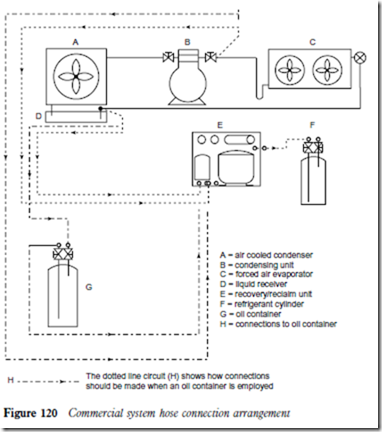Compressor lubricating oils
The traditional mineral and synthetic oils are not miscible (soluble) with R134a. Oils which are not miscible can become entrained in heat exchangers in undesirable amounts to prevent adequate heat transfer, thus reducing the system performance.
The new lubricants developed, polyol-ester (PE) and polyalkene-glycol are miscible. These oils have similar characteristics to the traditional oils. They are more hygroscopic, dependent upon the solubility of the refrigerant. This means that the oils readily absorb moisture from the atmosphere.
Special care must be exercised during service, storage, charging, during dehydration and evacuation to avoid chemical reaction in systems such as copper plating. PAG oils tend to be more critical and are mainly used where high solubility is required. Ester oils are preferred by the industry in the main and information to date regarding their usage has proved satisfactory when the moisture content in the oil does not exceed 100 ppm. Experience has determined that systems should be well dehydrated and evacuated and relatively large drier capacities should be provided.
Other oils available and supplied by Castrol are alkylene benzene 2283 and 2284 which supplement the polyol-ester Cinematic SW range.
Klee recommend EMKARATRL for use with Klea 407A, 407B and 407C application. This oil is fully compatible with these refrigerants.
Refrigerant reclaim
This refers to the process of removing refrigerant from a system to be passed through a reclaim unit using large capacity filter driers which are capable of retaining moisture and acid content. The reclaimed refrigerant is then discharged by the reclaim unit into refrigerant cylinders for re-use. Alternatively the reclaimed refrigerant can be despatched for processing by specialists.
Refrigerant recovery
By way of an example assume that a condenser was found to have developed a slight refrigerant leakage. The leak being on the high pressure side of the system rules out the possibility of any moisture contamination. Under these circumstances the refrigerant could be recovered by using a recovery unit, discharged into a service cylinder or cylinders if the charge is large. When repairs to the condenser have been completed the condenser should be pres- sure tested and evacuated. The recovered refrigerant can then be recharged into the system and the operating charge ‘topped up’ with the same refrigerant if necessary.
Due to the boiling points of various substances in refrigerant blends the actual recharging or initial charging of systems should be in liquid form. If a system is vapour charged there is a danger of drawing off from the refrigerant cylinder a greater quantity of one of the substances constituting the blend. This would undoubtedly alter the percentage of the mixture.
When reclaiming or recovering refrigerant from a commercial plant, whether the system compressor is operational or not, most of the refrigerant will be in the receiver and condenser in liquid form. The refrigerant is best removed from a system in liquid form using a reclaim unit. If it is possible to ‘pump down’ a system this task is much easier.
Obviously the process will be carried more rapidly and more efficiently if the refrigerant is drawn from both the high and low pressure sides of the system. The valve plate assembly of the compressor, expansion valve or the capillary will resist refrigerant passing through them. Inevitably some refrigerant will remain entrained in the oil which will settle in various parts of the system, for example the evaporator and compressor. If a compressor is fitted with a crankcase heater it can be actuated for a short period to raise the temperature of the crankcase oil which will then release the refrigerant from the oil. Defrost heaters on an evaporator can be employed in a similar manner.
Caution: Do not overheat the compressor or evaporator. The use of flame producing devices is not recommended for this purpose.
During a reclaim/recovery operation it is essential that sufficient cylinder capacity is available and double valve cylinders are desirable. Where possible cylinders should be cooled. Cylinders should never be overfilled.
It is an advantage to install an oil container between the recovery/reclaim unit and the liquid receiver of the system.
Refrigerant hoses
Most manufacturers of pressure hoses supply them complete with Shraeder connectors. These can be removed to further reduce any resistance to the flow of refrigerant during the reclaim/recovery operation.
